Larry Kim, Founder and CTO of Wordstream, and Robert J. Moore, Co-Founder and CEO of RJMetrics, have both built thriving SaaS companies. How did they take their companies from unknown startups to fast-growing businesses? For both of these founders, a big part of that strategy involved content marketing.
Larry has written blog posts that generated over 200k page views and been featured in Fast Company, The Washington Post, and Business Insider. Bob has used content marketing to fuel growth from employee 10 to employee 110. He’s written for the New York Times and had one of his data journalism pieces was referenced by Daniel Tosh.
Last week we got both of these content experts on a webinar to share the secrets of getting an unknown brand in front of massive audiences. If you missed it, you can download the slide deck, watch the full event below, or keep reading to catch the highlights.
Become Part of a Bigger Story
When you’re trying to get people to care about your brand new startup, your competition isn’t only other companies like you, it’s other things competing for attention — Buzzfeed, Facebook, Instagram, YouTube. That’s tough competition.
It’s impossible to break through all of this noise by shouting louder. Bob’s approach? Make your startup part of a bigger story. This is a strategy Bob has used multiple times over the years, from research on Twitter back in 2009 to analysis of the Ice Bucket Challenge last September. This strategy places what we do here at RJMetrics, data analysis, in the context of stories that people actually care about.
And this approach isn’t limited to analytics platforms, Larry did a similar thing when he wanted to inject Wordstream, a PPC management platform, into a broader story about Facebook’s IPO. Facebook’s IPO was garnering massive amounts of media attention so Larry put together a blog post and infographic that provided insight into a question that was on many people’s minds at that time, how does the value of Facebook’s advertising network stack up to Google’s? The piece got over 10,000 press mentions, pick ups in media outlets like Business Insider and the Wall Street Journal, as well as garnering over 10 million pageviews.
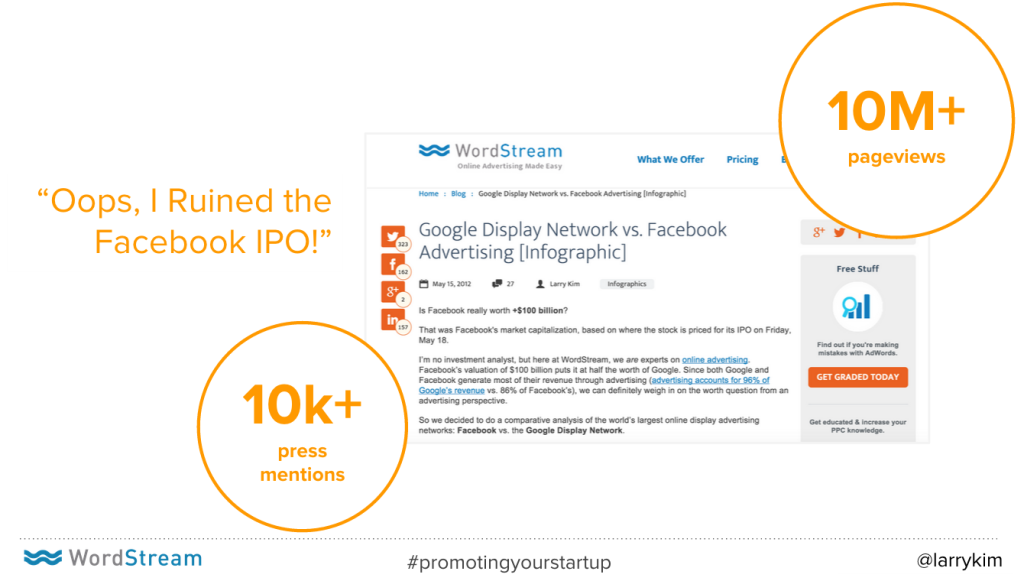
These examples may seem serendipitous, but Bob and Larry pointed out that a major reason they succeeded was because they avoided making the #1 mistake people make when writing “big win” content — failing to think promotion first.
The Two Rules for “Big Win” Content
When you’re trying to get your startup in front of a massive audience you need to have specific influencers, media outlets, and vendors in mind to promote to before even starting to create your content. If you don’t have an idea who will help promote the piece, and it’s on a topic that the press won’t care about, don’t waste time and effort creating it.
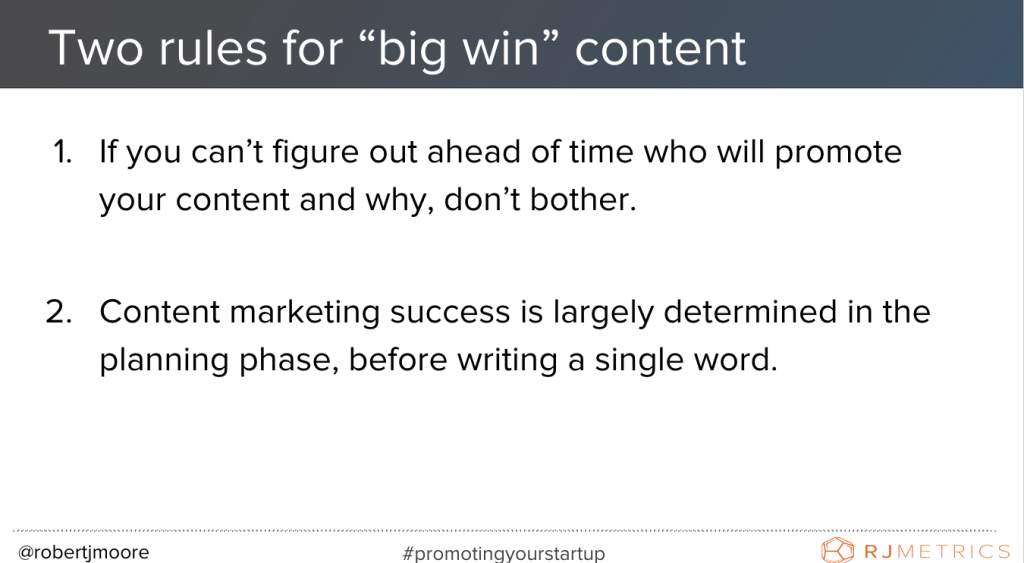
Larry pointed out another way to think about this is that you should be spending 80% of your time researching a piece, and only 20% of the time writing or creating the piece. The more work you are putting into the research and planning phase, the better chances of the piece reaching “big win” levels of success.
Using PPC for PR
Great content will get you very far, but once you’ve poured hours into creating an amazing piece, you should do everything you can to get it out there. Larry is a master at using paid ads to boost the reach of his content. Here are the steps he laid out:
- Always focus on quality score– If you create poorly designed ads, it won’t matter how good the content is that you’re promoting. And most ads are poorly designed, the top 1% of ads have a click through rate six times better than the rest.
- Tap into your customer’s emotions– If the ad triggers an emotional response, people are more likely to click.
- Publish high quality content– This seems like a no-brainer. But, it helps to be reminded that none of this works if you’re content isn’t great.
- Promote to influencers– Larry shared how he targets a list of influencers, and dedicates a small budget to promoting the content directly to them. This can garner media pick up without having to send a single pitch email.
- Say NO to promoting junk updates– Don’t abuse this type of promotion. You don’t want to use paid ads for every piece of content you create, save this for your “big win” content only.
- Remember who your audience is– Don’t forget to use language that matches the audience you’re going after when crafting your ads.
You can learn more about the steps involved in this approach here.
Optimizing for SEO to Create Sustained Value
These big pieces that get press attention and thousands of views are fun and exciting, but they’re not the only way to get in front of massive audiences. The other approach is the slower, sustained value that comes from an SEO play.
Bob shared an example from the early days of RJMetrics when he realized how unrealistic it was to target expensive and highly sought after search terms like “business intelligence” ($65.61 per click). So, instead of going after the expensive terms he looked at what other phrases prospects were searching for. For example, terms like ‘customer lifetime value,’ ‘how to conduct a cohort analysis,’ or ‘reduce churn rate’ all speak to the intent of an audience who would be looking for a business intelligence solution.
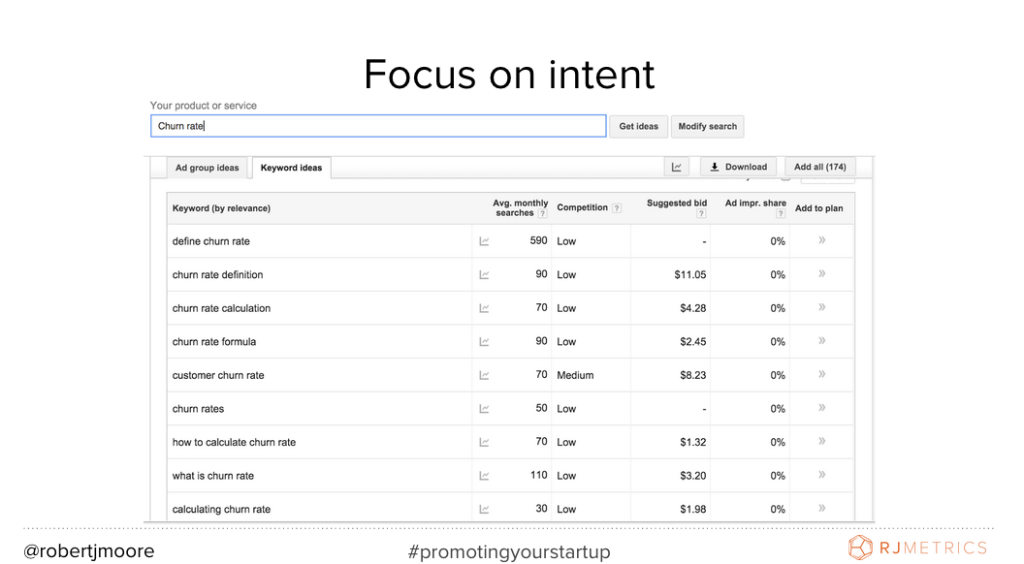
He conducted keyword research around these intent driven phrases, found those with the biggest opportunity, and created blog posts that addressed these phrases. Initially these posts gained some traction, but he realized this the type of content needed to be evergreen to build long term value.
This led to microsites like churn-rate.com which went on to generate thousands of highly targeted visitors a month. By comparison, generating that kind of traffic with PPC would have cost tens of thousands of dollars a month. These sites were developed over two years ago, but today they are still delivering highly volumes of highly qualified leads.
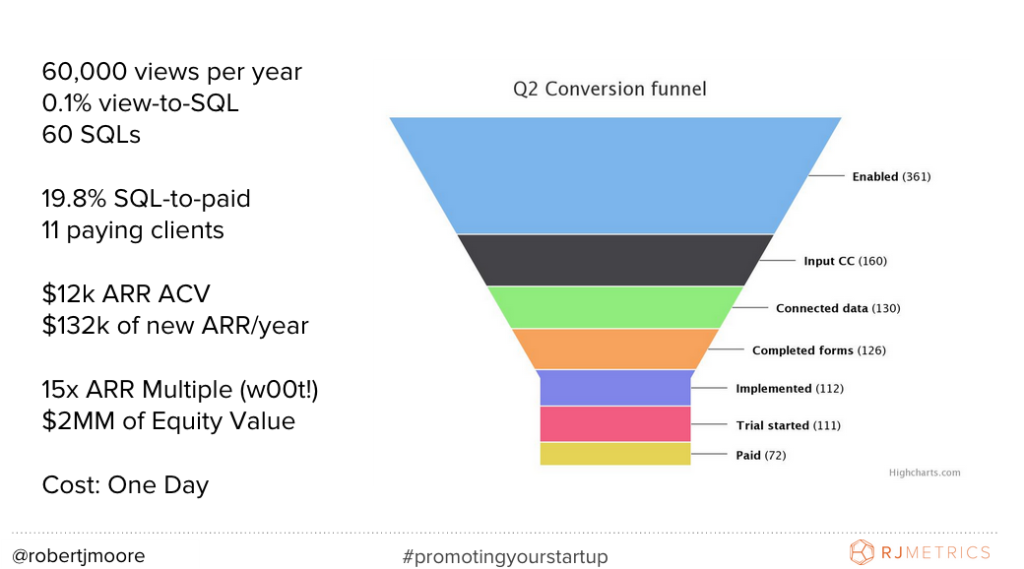
Which underscores a point that both Larry and Bob made — the vast majority of value derived from content comes from a small number of pieces. “Content unicorns,” if you will.
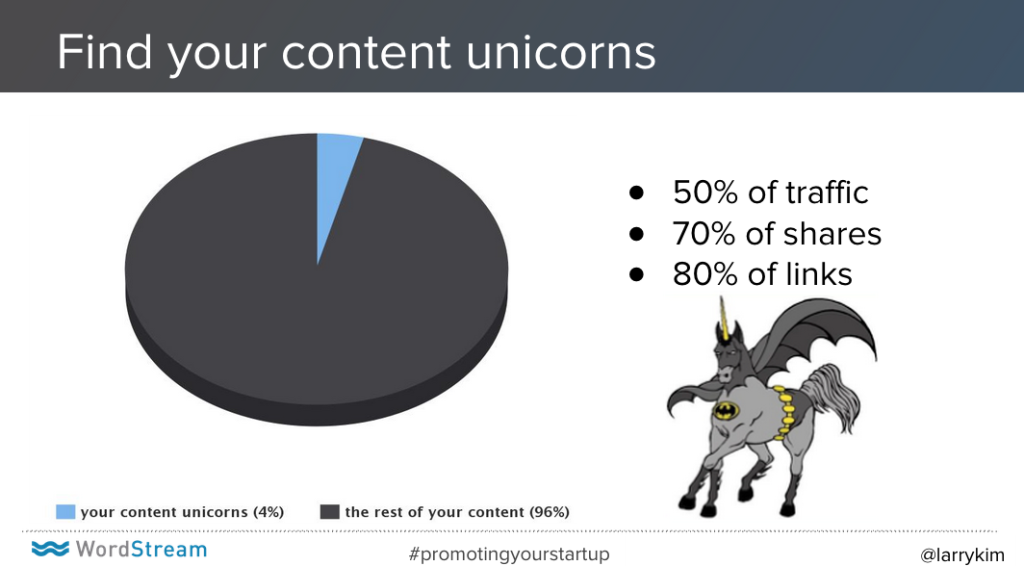
Why It Works
Generating this kind of content is fun and exciting, but aside from the microsites, is “big win” content really worth it? When a startup gets published in Fast Company what’s the actual impact on the bottom line?
Bob explains the impact of this kind of content as a “reciprocity index.” A company’s reciprocity index is the ratio of how much value your company delivers, to the value your company receives in return.

You have a reciprocity index for customers, but this also exists for people that aren’t your customers — reporters, influencers, leads in your database. When you ask for someone’s attention, you need to deliver something of value, something that they care about already. This is what Larry’s post about Facebook vs. Google ad spend achieved, and what Bob pulled off with his 2009 Twitter analysis.
Alot of these efforts don’t directly translate into leads, but they’ll get something every startup needs as they’re trying to break through the noise — attention. It’s a way to grab the attention of reporters that couldn’t care less about the next “Uber for XYZ” or your innovative ideas. It’s the way to get in front of investors who won’t read your pitch, but are looking for a fresh perspective on Pinterest’s valuation.
The tactics Larry and Bob shared boil down to the following: PRable content is fuel for your startup. Find a fresh perspective on a topic people already care about, use paid ads to promote that content fast, use SEO to maintain momentum over time. Together, these tactics will help maintain the reciprocity index of your audience, and help you build a massive audience of people who care about your company.
